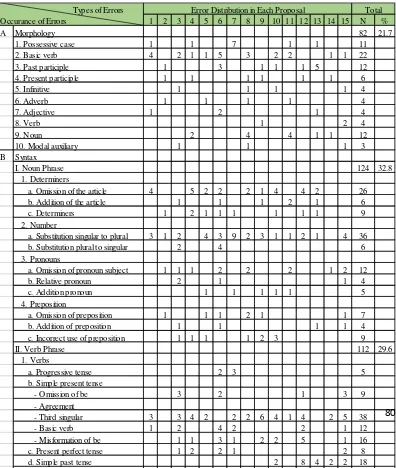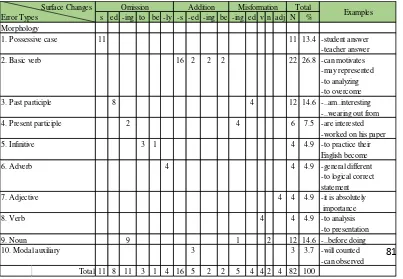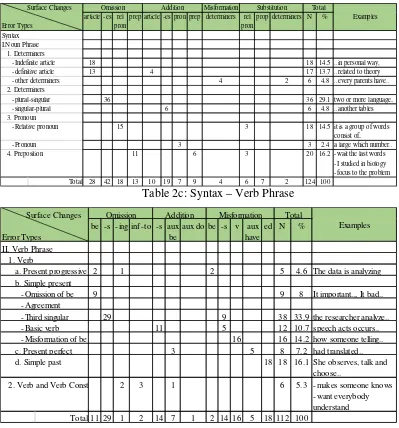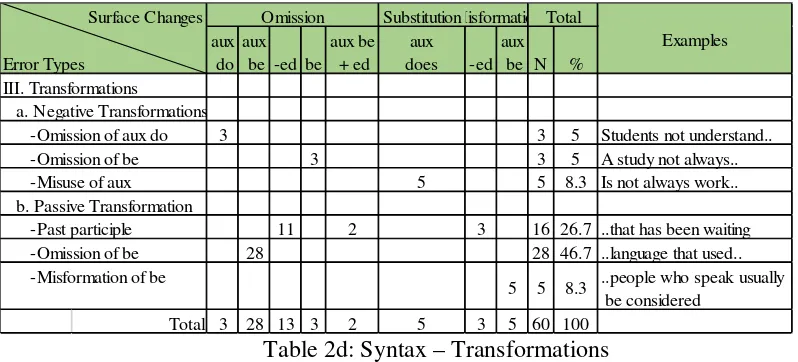77 AN ANALYSIS OF GRAMMATICAL ERRORS PRESENT
IN FINAL PROJECT PROPOSALS MADE BY ENGLISH STUDY PROGRAM STUDENTS
OF BATANGHARI UNIVERSITY JAMBI
Wennyta1
Abstract: Penelitian ini dilakukan dengan cara menganalisa proposal-proposal tugas akhir yang dibuat oleh mahasiswa semester akhir di jurusan pendidikan bahasa Inggris. Sampel diambil dari 15 proposal tugas akhir yang ditulis oleh mahasiswa-mahasiswa jurusan pendidikan bahasa Inggris yang masih kuliah di semester kedelapan, tahun ajaran 2015-2016, di FKIP Universitas Batanghari. Tujuan dari penelitian ini adalah untuk menemukan jenis kesalahan-kesalahan grammar di proposal-proposal tugas akhir mahasiswa dan seberapa sering kesalahan itu dibuat. Kesalahan-kesalahan yang ditemukan kemudian di identifikasi dan diklasifikasikan menggunakan kategori taksonomi linguistik sebagai basisnya. Hasil yang ditemukan kemudian didefinisikan berdasarkan jenis kesalahan morfologis dan dansintaksis. Hasil dari penelitian ini diharapkan dapat membantu mahasiswa dan umum tentang jenis kesalahan yang umum ada pada karya tulis dan membantu mereka memusatkan usaha mereka untuk menghindari kesalahant ersebut. Dari limabelas proposal mahasiswa yang diteliti, ditemukan 378 kesalahan. Hasil menunjukkan bahwa jenis kesalahan yang paling umum muncul pada kelima belas proposal mahasiswa adalah kesalahan penghilangan. Kesalahan penghilangan ditemukan dalam jumlah yang sangatsignifikan disbanding jenis kesalahan lainnya. Ditemukan 231 kesalahan penghilangan, yang merupakan 61.1% dari semua kesalahan yang ditemukan.
KataKunci: Analisis grammar, analisis kesalahan, kesalahan grammar, penyebab kesalahan.
BACKGROUND
English is taught as a foreign language in Indonesia. It is taught in all steps of education, elementary, junior high school, and senior high school. At university level, some choose to enter English Language Education program. Students that entered English Study program are required to write their final project in English. By the time they are asked to do so, they’ll already learned English for 10 years. Looking at their experience, it is logical to assume that they are already capable of writing in perfect English. In actuality, many of them aren’texempt from making grammatical errors in their writing.
In learning foreign language, students learn about system that was used by native speakers of that particular language. This system is“TheLanguage Learner System and the Target Language System”. Students often influenced by their mother tongue that it makes them face difficulty in learning the target language, like what Selingkar said in Ellis (1998, p48) “fail to reach the target language
1
78
competence”. This fact often made the final project supervisor of English students’ proposal complain about the grammatical quality of their students’ writings, some of these writings may even contain grammatical errors that are very obvious and utterly mistaken.
There are some definitions that are correlated with the term “error”.Dulay Burt and Burt (1982) define error as “The flawed side of learner speech or writing” which “deviates from some selected norm of mature language performance”. They further explained that errors should be differentiated according to their cause. There are errors that are made because the writer’s lack of grammatical knowledge which they called “Competence Error”. Furthermore, Brown (2000) said that “A mistake indicates a failure to utilize a known system correctly whereas an error indicates the competence of the learners”. This assert the difference between them, which people often find difficult to distinguish which ones are mistakes and which ones are errors in a writing.
The most important thing is to determine where the students made most of their mistakes. This has to be understood and naturally, also how they should correct their mistakes.
This research is expected to be able to find the types of grammatical errors made by students in writing their research proposals. The identification of errors and how often they occurred will help research supervisors in guiding their students because they’ll now know which way to focus in fixing their students’ grammatical errors based on which type that occurred the most. This also help lecturers that teach grammar in finding the proper learning and practice materials to assist their students in their weakest link of their grammar skill. This will result in overall improvement of English Language Education program in the future.
This research follows error classification made by Politzer and Ramirez, the description is as follows:
Types of Grammatical Errors
Politzer and Ramirez classified the errors into the following types. A. Morphology
1. Indefinite article 2. Possessive case
3. Third person singular verb 4. Simple past tense
5. Past participle 6. Comparative B. Syntax
1. Noun phrase a. Determiners b. Normalization c. Number d. Pronouns e. Prepositions 2. Verb phrase
79
c. Agreement of subject and verb 3. Verb and verb construction 4. Word order
5. Some transformations a. Negative transformations b. Question transformations c. There transformations d. Subordinate transformations
To describe the errors, surface strategy taxonomy is used to show the ways surface structures are altered. There are five categories proposed by Dula, Burt, and Krashen, namely: omission, addition, misformation, and misordering (1982,p50), defined in the following.
1. Omission : The absence of an item that must appear in a well-formed utterance
2. Addition : The presence of an item that must not appear in a well-formed utterance
3. Misformation : The use of a wrong form of the morpheme or structure Misordering : The incorrect placement of a morpheme or group of morpheme in an utterance.
METHODOLOGY
This research is a descriptive qualitative research that was conducted in English Language Education program in FKIP of Batanghari University year 2016. The subject of this research is proposals made by students who are still working on their final project as a requirement for them to complete their bachelor degree.
Grammar errors that are found in each proposals would be identified and counted. It will further analyzed to determine each types of errors using Linguistic Category Taxonomy classification by Politzer and Ramirez (In Dulay, Burt and Kroshen 1982; p146).
The data are later described according to Surface Strategy Taxonomy. Things to look for are whether there are important elements that are missing from the grammar, is there any irrelevant elements that are added, or whether some elements are misformatted or misordered. The analysis is then presented in form of table to show each types of errors from 15 proposals, each of the errors will be graded according to their rate of occurrence.
This research use 15 final project proposals from students of English Language Education program in FKIP of Batanghari University, Jambi. Their year of admission vary, but they all have studied for at least seven semesters.
The technique of data collection for this research are as follows:
80
1 2 3 4 5 6 7 8 9 10 11 12 13 14 15 N %
A Morphology 82 21.7
1. Possessive case 1 1 7 1 1 11
2. Basic verb 4 2 1 1 5 3 2 2 1 1 22
3. Past participle 1 3 1 1 1 5 12
4. Present participle 1 1 1 1 1 1 6
5. Infinitive 1 1 1 1 4
6. Adverb 1 1 1 1 4
7. Adjective 1 2 1 4
8. Verb 1 2 4
9. Noun 2 4 4 1 1 12
10. Modal auxiliary 1 1 1 3
B Syntax
I. Noun Phrase 124 32.8
1. Determiners
a. Omission of the article 4 5 2 2 2 1 4 4 2 26 b. Addition of the article 1 1 1 2 1 6
c. Determiners 1 2 1 1 1 1 1 1 9
2. Number
a. Substitution singular to plural 3 1 2 4 3 9 2 3 1 1 2 1 4 36 b. Substitution plural to singular 2 4 6 3. Pronouns
a. Omission of pronoun subject 1 1 1 2 2 2 1 2 12
b. Relative pronoun 2 1 1 4
c. Addition pronoun 1 1 1 1 1 5
4. Preposition
a. Omission of preposition 1 1 1 2 1 1 7 b. Addition of preposition 1 1 1 1 4 c. Incorrect use of preposition 1 1 1 1 2 3 9
II. Verb Phrase 112 29.6
1. Verbs
a. Progressive tense 2 3 5
b. Simple present tense
- Omission of be 3 2 1 3 9
- Agreement
- Third singular 3 3 4 2 2 2 6 4 1 4 2 5 38
- Basic verb 1 2 4 2 2 1 12
- Misformation of be 1 1 3 1 2 2 5 1 16 c. Present perfect tense 1 2 2 1 2 8
d. Simple past tense 2 8 4 2 2 18
2. Verb and verb construction 3 2 1 6 Error Distribution in Each Proposal Total Types of Errors
Occurance of Errors
2. Critical reading technique: If needed, a much more critical method of reading will be employed to find all errors that may escape faster reading method.
Data in this research will be processed using these following methods: 1. Data that have been collected are then classified according to every types
of errors by giving them a code to make the process easier.
2. Data that have been collected are later summed according to their types. 3. Every types that are found are analyzed according to the correct grammar
and proper English.
Researcher make a conclusion based on the entire analyzed data.
Findings and Discussions
In the fifteen proposals that were observed, there were many incorrect sentences found. Each sentence contains at least one error. Some of them contains two, three, or even more errors. Overall, 386 errors were found in these 15 students’proposals.The details on the errors could be seen in the Tables below.
81
s ed -ing to be -ly -s -ed -ing be -ing ed v n adj N %
11 11 13.4 -student answer
-teacher answer 16 2 2 2 22 26.8 -can motivates
-may represented -to analyzing -to overcome 8 4 12 14.6 -..am..interesting
-..wearing out from
2 4 6 7.5 -are interested
-worked on his paper 3 1 4 4.9 -to practice their
English become 4 4 4.9 -general different
-to logical correct statement 4 4 4.9 -it is absolutely
importance 4 4 4.9 -to analysis
-to presentation 9 1 2 12 14.6 -..before doing
3 3 3.7 -will counted -can observed Total 11 8 11 3 1 4 16 5 2 2 5 4 4 2 4 82 100
2. Basic verb
Surface Changes Error Types
Omission Addition Misformation Total
Examples
Morphology 1. Possessive case
9. Noun 10. Modal auxiliary 3. Past participle
4. Present participle
5. Infinitive
6. Adverb
7. Adjective
8. Verb
III. Transformations 60 15.9
1. Negative transformation
a. Omission of auxiliary, do 1 1 1 3
b. Omission of be 1 1 1 3
c. Incorrect use of auxiliary 2 1 2 5
2. Passive transformation
a. Past participle incorrect 2 4 4 4 1 1 16
b. Omission of be 4 2 11 1 4 1 1 2 1 28
c. Misformation of be 1 1 1 1 1 5
TOTAL 18 9 36 22 16 48 32 38 21 26 15 31 19 12 35 378 100
According to linguistic category, there were two types of errors found in 15 proposals that were observed, they are morphological and syntactic errors. Morphological errors are errors that concern the use of basic verb, possessive case, past participle, present participle, infinitive, adverb, adjective, verb and noun. Syntactic errors concern the errors in noun phrase, verb phrase, and transformation. Errors in noun phrase are in verb be, tenses, present progressive, simple present, simple past, present perfect, verb and verb construction, and transformations consisting of negative transformation and passive transformation. Besides, to show what surface changes made, the errors were classified based on surface strategy taxonomy. All these error types were summarized in the appendix presented in the Linguistic Category Taxonomy (Table 1) and Linguistic Category and Surface Strategy Taxonomy (Table 2) which are subdivided into four sub-tables. They are Table 2a: Morphology, Table 2b: Syntax-Noun Phrase, Table 2c: Syntax-Verb Phrase, Table 2d: Syntax Transformations.
82
Table 2b: Syntax
Table 2c: Syntax–Verb Phrase
Misformation article -es rel
pron
prep article -es pron prep determiners rel pron
prop determiners N %
18 18 14.5 ..in personal way,
13 4 17 13.7 ..related to theory
4 2 6 4.8 ..every parents have..
36 36 29.1 two or more language..
6 6 4.8 ..another tables
15 3 18 14.5 it is a group of words
consist of..
3 3 2.4 a large which number..
11 6 3 20 16.2 -wait the last words
-I studied in biology -focus to the problem
Total 28 42 18 13 10 19 7 9 4 6 7 2 124 100
Examples Substitution
Syntax I.Noun Phrase
3. Pronoun 1. Determiners Surface Changes
Error Types
Omission Addition Total
-Relative pronoun
-Pronoun 4. Preposition -Indefinite article -definitive article -other determiners 2. Determiners -plural-singular -singular-plural
be -s -ing inf -to -s aux be
aux do be -s v aux have
ed N %
2 1 2 5 4.6 The data is analyzing b. Simple present
-Omission of be 9 9 8 It important.., It bad.. -Agreement
-Third singular 29 9 38 33.9 the researcher analyze.. -Basic verb 11 5 12 10.7 speech acts occurs..
16 16 14.2 how someone telling.. 3 5 8 7.2 had translated..
18 18 16.1 She observes, talk and choose..
2 3 1 6 5.3 -makes someone knows -want everybody understand Total 11 29 1 2 14 7 1 2 14 16 5 18 112 100
2. Verb and Verb Constr II. Verb Phrase
1. Verb
a. Present progressive
-Misformation of be c. Present perfect d. Simple past
Examples Surface Changes
Error Types
83
Table 2d: Syntax–Transformations
From the errors table that was made, error distribution and frequency of occurrence can be discussed. The distribution of all the error types, their frequency of occurrences in each proposal, and the total number of occurrences of each type of error, presented in appendix Table 1 Linguistic Category Taxonomy, indicates that each proposal contains errors. It shown, in addition, that the error types that occur in students’ proposals were not evenly distributed. Some types occur only once in one proposal, some occur in two to eight proposals, others occur in eleven to fourteen proposals.
The error with the least number of occurrence are morphological errors in modal auxiliary and syntactic errors in transformation, which are omission of aux do and omission of be. There are only 3 proposals that made this errors. This means there are only 3 students that make this error, while the other 12 have no problem with this aspect.
Error type that occurred the most often is the agreement type. There are 50 of this error that are distributed in thirteen proposals. This means that only 2 out of 15 students that are free from this type of error. The next error with the most occurrence is passive transformation–omission of be; there are 28 cases occurred distributed in 10 proposals.
Another interesting fact to be noted is that one type of error may occur many times in the same proposal. For example, the error in possessive case appears only once each in proposal 1, 4, 11, and 13, while it occurred seven times in proposal 7. Similarly, there is one occurrence of error in the use of plural nouns in proposal 2, 10, 11, and 13, while the same type of error occurred 9 times in proposal 7.
Overall, there are much more syntactic errors compared to morphological ones. Morphological errors make up to 21.7% of all errors in the 15 proposals while 78.3% of other errors were syntactic ones (Appendix Table 1). The predominant morphological errors are the basic verb or the unmarked verb used after infinitive to, and modal auxiliaries which were made by the addition third singular inflection, past tense, past participle, and present participle inflection (appendix Table 2, Morphology).
Substitution aux
do aux be -ed be
aux be + ed
aux does -ed
aux be N %
3 3 5 Students not understand..
3 3 5 A study not always..
5 5 8.3 Is not always work..
11 2 3 16 26.7 ..that has been waiting
28 28 46.7 ..language that used..
5 5 8.3 ..people who speak usually be considered
Total 3 28 13 3 2 5 3 5 60 100
a. Negative Transformations -Omission of aux do
-Misformation of be Surface Changes
Error Types
-Omission of be -Misuse of aux b. Passive Transformation -Past participle -Omission of be
Omission Misformation Total
Examples
84
The most predominant syntactic error is the noun phrase category, which has 124 occurrences or 32.8% of all errors found in the 15 proposals. Within the noun phrase category, number comprised the predominant type, having 42 occurrences, 36 cases of which were the omission of plural inflection (appendix table 2b: Syntax-Noun phrase).
Within the verb phrase category, the formation of simple present tense comprised the most predominant type of error (appendix Table 2c: Syntax–Verb Phrase), particularly related to subject verb agreement, the omission of the third singular verb inflection, comprising 33.9% of the verb phrase errors. Within the transformation category, passive transformations with the omission of the auxiliary be is the most predominant type, having 46.7%of occurrences (appendix, Table 2d).
Viewed from the surface strategies, the most predominant type, both from morphology and syntactic categories is omission. Overall, there are 231 errors concerning omission or 61.1% of all errors found in the proposals. The omitted part is mostly inflectional suffixes: possessive case (-s), plural inflection (-es), and noun forming derivational suffix (-ing). Another omission of bound morpheme is one instance of the omission of adverb-forming derivational suffix (-ly). In addition, there are several omissions of free morphemes, indefinite article, definite article, relative pronoun subject, prepositions, be as auxiliary and main verb, and also omission of subject and verb.
The Surface Strategy Taxonomy reveals that, besides the types of omission discussed above, changes made to the other two surface strategies is of the bound morphemes, specifically, inflectional suffixes.
Those that occur in the addition type are third singular infliction (-s), past tense infliction (-ed), present participle infliction (-ing), past participle infliction (ed), and plural infliction (-es), while errors that occur in misformation type are present participle infliction ing), past participle ed), and past tense infliction (-ed).
The findings of this study show that some proposals have only two types of errors, showing considerable mastery of English grammar on the students. On the other hand, some proposals show a relatively higher occurrence of errors, which are mostly related to changes made to the English inflictions being omitted, added, or misformed.
Conclusion and Suggestion
From the analysis of the grammatical errors in students’ final project proposal was completed, there are three conclusions that can be made.
1. The collected data were classified based on Linguistic Categories and Surface Strategies. This resulted in a three dimensional taxonomy, showing the types of errors linguistically and the surface changes made to each type of errors.
85
and there transformation and agreement. On the other hand, some error types found in this study were not listed in the guideline classification, such as errors in present perfect, basic or common verb, modal auxiliary, and passive transformation.
3. From this study, it’s found that the most common type of errors found in fifteen students’ proposal that are studied are omission error. Omission error was found in overwhelming number compared to other errors. There were 231 omission errors found which comprised 61.1% of all errors.
Some suggestions can also be made from the result of this study, they are: 1. This study, hopefully, can cast a light on students’ grammatical problems
as a clue for teachers. Teachers can use this information to help their students so that they can avoid making the same mistakes in the future. Teachers can focus their lessons on fixing the grammatical weakness of their students.
2. When a student makes an error, the teacher should be able to detect it, diagnose it, and follow it up with an effective correction strategy. Conveying grammatical information accurately and concisely is an important part ofteacher’sjob.
BIBLIOGRAPHY
Allen, Stannard W (1974). Learning English Structure, 9th Edition, Longman, London.
Azar, Scampfer Betty (2006) Fundamentals of English Grammar, Longman.com United States of America.
Brown, H.D. (2000). Principles of Language Learning and Teaching. New York: Person Education.
Close, R.A. (1981), English as a Foreign Language, London, Allen and Union. Cresswell W.J. (1998) Qualitative Inquiry and Research Design. Sage
Publications, London, New Delhi
Dulay, H. S. Burt, M and Krashen, S (1982). Language Two, New York: Oxford University Press.
Ellis, R (1998) Understanding Second Language Acquisition, Oxford University Press.
Fitikedes, T.J,(1978), Common Mistakes in English, 5th Edition, Longman, London.
Hornby (1982). Oxford Advanced Learners Dictionary of Current English. London. Oxford University Press.
James, C (1998) Errors in Language Learning and Use, England, Addison Wesley Longman Limited.
Kirk Patrick George (1991) English Checklist, Common Errors in English, BinarupaAksara, Grogol Jakarta Pusat.
86
Mas’udFuad (1991) Essentials of English Grammar, A Practical Guide, BPFE-Yogyakarta
Murphy Raimond (1998) English Grammar in Use, Cambridge University Press. Palmer, F.R. (1974) The English Verb. Longman
Richards, J.C. (1971). A non-contrastive approach to Error Analysis. English Language Teaching Journal, 25, 204-0219.



